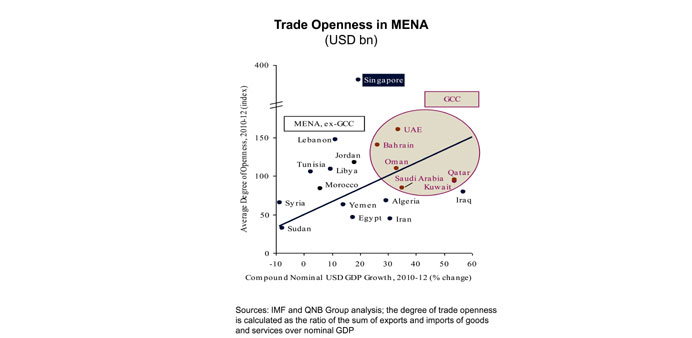|
Qatar project spending estimated at $30bn this year and large-scale projects across the GCC will drive the region’s growth in 2014, a new report has shown. |
In the short term, the GCC (Gulf Co-operation Council) region will drive Mena (Middle East and North Africa) growth, mainly through heavy spending on infrastructure, a QNB report said yesterday.
In the GCC region, many countries including Saudi Arabia ($50bn) and Kuwait ($25bn) have huge project spending outlay this year.
Dubai’s successful bid for the World Expo 2020 and a number of new real estate developments will boost project spending in the UAE. The Saudi government alone is spending in excess of $50bn on infrastructure projects through its budget, which excludes significant project spending by the private sector and state-owned companies.
The report also said greater integration into the global economy of the Mena (ex-GCC region) through increased trade openness and enhanced competitiveness could raise long-term regional growth prospects. Mena growth is a tale of two regions, the Mena ex-GCC and the GCC acting as a locomotive of growth for other countries.
High hydrocarbon production and prices have lifted export and fiscal revenue in the GCC, enabling Gulf countries to press ahead with major infrastructure spending plans.
The GCC leads the region in terms of integration into the global economy through trade openness and competitiveness. Nonetheless, structural reforms aimed at liberalising trade and investment would most likely yield a growth dividend in the long-term across Mena, QNB said.
QNB estimates that real GDP growth in the GCC was 3.7% in 2013, compared with 1.2% in the rest of Mena. This is relatively sluggish compared with potential and historical average Mena growth of around 5% or higher.
A number of Mena countries outside the GCC are undergoing political transition, creating uncertainty that deters investment, weakens short-term growth and delays much-needed reforms. However, a gradually improving political outlook in some of these countries, combined with the potential upside from economic reform, leaves room for higher short- and long-term growth across the region, the report said.
Integration into the global economy can be measured by the degree of trade openness, defined as the ratio of the sum of exports and imports of goods and services over nominal GDP. By this measure, there is a strong positive relationship between greater integration and higher growth over the long-term.
GCC countries continue to be at the top of the Mena grouping, partly reflecting their large hydrocarbon export sectors, QNB said. However, both the GCC and the rest of Mena still demonstrate room for improvement compare to global leaders in trade openness, such as Singapore. This suggests that greater trade openness has the potential to yield a significant long-term growth dividend for Mena and can be achieved through policies to remove barriers to trade.
Competitiveness is another key aspect of global integration. The 2013-14 Global Competitiveness Index by the World Economic Forum (WEF) shows the GCC countries in the top league, with the rest of the Mena region lagging behind. This mirrors the recent economic growth performance of the Mena region, QNB said.
The WEF report identified areas for enhancing competitiveness in Mena: institutional frameworks and labour markets in North Africa as well as infrastructure, innovation and competitiveness. Structural reforms aimed at improving these dimensions of competitiveness could, therefore, lead to higher sustainable growth, QNB said.
Greater efforts to attract investment into infrastructure, including the GCC countries, would likely yield high growth dividends in the entire region, QNB said.
In the GCC, investment in major infrastructure programmes will continue to drive trade openness through higher imports. Further structural reforms aimed at attracting foreign investment into infrastructure, education and innovation would yield long-term gains in enhancing both trade openness and competitiveness.
The GCC is already investing heavily in these areas, but further liberalisation and investment incentives could bring the region in line with cutting-edge global standards, the QNB report said.
Increased trade openness and enhanced competitiveness could raise long-term regional growth prospects.
“Growth in Mena, outside the GCC, will be dependent on overcoming political uncertainties, liberalising trade and improving competitiveness,” the report said.

